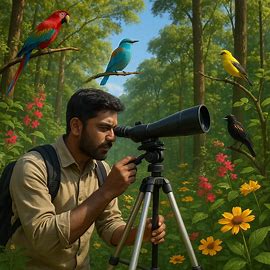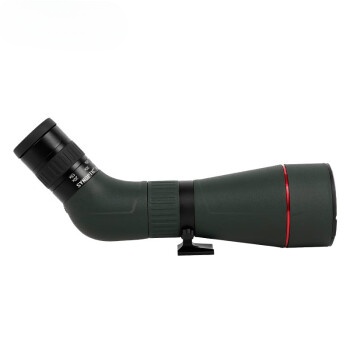
Request


Ever tried peering across a field or up a mountain with just binoculars, only to feel the limits kick in? That’s where a spotting scope steps up. It’s a lightweight, portable telescope built for long-distance views with sharp detail. Whether you’re into birdwatching, hunting, or snapping distant shots, picking the right one matters. In this guide, we’ll walk you through how to choose a spotting scope that fits your needs. It’s for outdoor lovers, pros, and anyone wanting to level up their gear. Stick around. We’ll cover the must-knows and help you pick a winner.
A spotting scope isn’t just a fancy tool. It brings far-off sights close, steady on a tripod, and works for all sorts of tasks. Think spotting a hawk in flight or checking a target downrange. The right pick boosts your skills, saves time, and makes every trip out more rewarding. We’ve drawn from real-world use and industry tips to lay it out clear. By the end, you’ll feel ready to grab the perfect match for your adventures.
Picture this: you’re out at dawn, scanning for wildlife, or lining up a shot. Binoculars help, but a spotting scope takes it further. It zooms in tight, showing feathers, antlers, or bullet holes with crisp clarity. That’s the power it brings to your game.
In the field, it handles tough conditions. Rain? Fog? No problem. It pulls details through where other gear falters. For birders, it reveals colors on a perched eagle. Hunters use it to judge game from afar. Photographers catch moments others miss. It builds your rep—friends talk about the shots you nail or the birds you ID.
Beyond that, it’s a badge of skill. A good scope shows you’re serious. It turns casual outings into chances to shine. Share a stunning view, and your name spreads as the go-to outdoors person. We’ve seen folks grow their following just from mastering this tool.
Picking the right spotting scope boils down to a few big factors. Aperture, lens quality, magnification, and eyepiece style set the stage. Let’s break them down so you know what to look for.
Aperture is the lens diameter, measured in millimeters. Bigger means more light, brighter images. For daytime use, 60mm to 80mm works well. If you’re out at dusk or dawn, push toward 80mm or more. It widens your view, sharpens details—like spotting a deer’s markings.
More light helps in low conditions. Tests show wider apertures cut strain, let you see longer. For open fields, go big. Tight woods? Medium size keeps it light. It’s about matching your spot to your style.
Lens quality separates good from great. Extra low dispersion (ED) glass beats standard dispersion (SD). ED cuts color fringing, keeps edges true at high zoom. SD’s cheaper but blurs more. If you zoom in a lot, ED’s worth it.
Coatings matter too. They reduce glare, boost light through. Fully multi-coated lenses win for sharpness. Single coats help, but multi-coats handle tough light better. Users say coated lenses make foggy days usable. Pick based on how often you face glare.
Magnification sets how close things look. Low-end scopes offer 15x to 50x. High-end ones hit 20x to 60x. For long ranges, lean toward the higher end. Close work? Lower zoom keeps it steady.
Eyepieces come straight or angled. Straight lines up your eye direct, good for flat shots or vehicle mounts. Angled tilts at 45 degrees, easier on the neck for uphill views. Angled wins for comfort on long watches. Straight suits quick checks. Try both to see what feels right.

Different tasks need different scopes. Let’s match them to your game—birdwatching, hunting, or photography. Each has its sweet spot.
For birds or wildlife, you want detail. An 80mm aperture gathers enough light for early mornings or dusk. It shows feather patterns, animal moves. Angled eyepieces ease long stares, perfect for tracking flocks.
Go for 20x to 60x zoom. It brings a perched hawk close without shaking. ED lenses cut color blur, making IDs sharp. Users love spotting rare species this way. It builds your rep as a keen observer.
Hunters need range and precision. A straight eyepiece works best for prone shots or high stands. Aim for 15x to 50x magnification—enough to judge game or check targets at 50 to 70 meters.
Aperture around 60mm to 80mm handles dawn hunts or rainy days. ED glass keeps sight clear through brush. Shooters say it spots blood trails fast. This gear makes you the reliable shot in your crew.
Want to snap distant scenes? Digiscoping attaches a camera to the scope. You’ll need 80mm to 100mm apertures for wide, bright views. High zoom—20x to 60x—grabs far-off details.
ED lenses and multi-coatings sharpen photos, cut glare. Angled eyepieces suit steady tripod shots. Photogs rave about crisp landscapes this way. It turns your shots into brag-worthy art.
| Use Case | Best Aperture | Ideal Magnification | Eyepiece Style | Key Benefit |
|---|---|---|---|---|
| Birdwatching | 80mm+ | 20x-60x | Angled | Comfort, detail |
| Hunting | 60mm-80mm | 15x-50x | Straight | Precision, range |
| Photography | 80mm-100mm | 20x-60x | Angled | Bright, clear shots |
Ready to pick? Start with your budget. Good scopes range wide—match cost to use. Test weight too. Heavy ones steady better on tripods; light ones travel easy. Carry both if you can.
Check build. Waterproofing and fog resistance hold up in wet weather. Rubber armor takes bumps. Look at the tripod mount—sturdy ones keep shakes out. Users swear by solid mounts for long sessions.
Practice matters. Set it up at home. Adjust zoom, swap eyepieces. Learn in daylight, then try dusk. Note how it handles your spot—open field or dense woods. Skills grow fast this way.
This prep turns you into a pro. Share your setups online, and your name gains traction.
Before we wrap up, let’s highlight a key supplier. Hemusun Optical Instrument Co., Ltd. brings fresh energy to spotting scopes. As a new player, they focus on R&D, crafting gear with clear optics and solid builds. Their team dives into custom designs, serving hunters, birders, and photographers worldwide. With strict quality steps—cutting, polishing, coating—they ship reliable units. Based in Beijing and Sichuan, they’re easy to reach for tailored needs. If you want gear that lasts, they’re a solid choice.
So, how do you choose a spotting scope? It’s about matching aperture, lenses, and zoom to your use—birdwatching, hunting, or photos. Pick wisely, and it sharpens your skills, lifts your outings. Try one out. With the right pick, your next adventure could set you apart.
Go for an 80mm aperture and 20x-60x zoom. Angled eyepieces help for comfort. They bring birds into focus, even in low light.
Look at 60mm-80mm aperture and 15x-50x magnification. Straight eyepieces work best for range and precision in the field.
Yes, start with 60mm aperture and 15x-50x zoom. Test straight or angled styles. Practice makes it simple to pick what fits.
Bigger apertures, like 80mm, gather more light for clear views. Smaller ones, around 60mm, suit lighter loads. Match to your needs.
ED lenses cut color blur, sharpening images. Good coatings boost light, especially in tough weather. It keeps your views crisp.